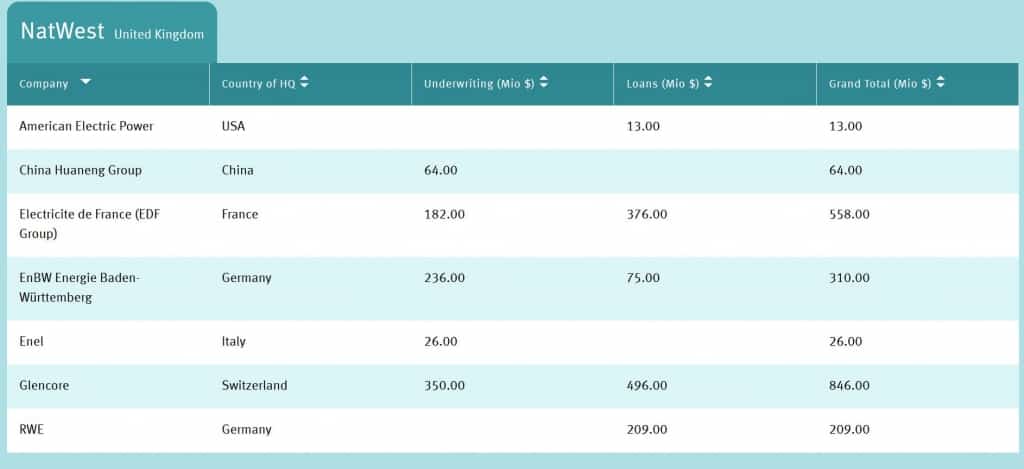NatWest has been working hard to act like a climate leader, joining climate coalitions, hiring a new climate chief, and plastering its logo all over COP26 at the end of this year. This seems like a good time to take a closer look at where NatWest stands on fossil fuel financing.
The bank has committed to aligning its lending and investment portfolios with net-zero emissions by 2050, and to a coal exit date. However, it’s too early to celebrate. According to the latest Banking on Climate Chaos report, NatWest is still in the top 50 most polluting banks in the world, channeling more than $13 billion in fossil fuel financing over the past five years (2016-2020) and there is no obvious downward trend. NatWest still has to prove it deserves a gold star for its climate ambitions, if it wants to be a credible sponsor for the COP26 summit.
Lack of clarity on its coal phase out plan
In 2019, NatWest has committed to a “full phase-out from coal by 2030”, but the details of this commitment are still missing. Does a full phase out mean that NatWest will have stopped financing and will have zero exposure to any company above 0% of revenues from coal by the first of January 2030, both on the mining and the power side? It is critical that NatWest clarify the policy, which is otherwise too flexible to effectively phase out the bank’s current coal financing. According to the Global Coal Exit List, NatWest’s support to the coal industry was worth more than $2 billion in underwriting and loans from October 2018 to October 2020, of which $846 million was in support of Glencore. Glencore is the 9th biggest coal mining company worldwide, accountable for the annual production of around 120 million tons of coal and without a plan to phase out by 2030. It is also associated with allegations of human rights violations, particularly in Columbia. Another example is RWE, a major European coal player with no plan to shut down its coal assets by 2030 and which is suing the State of Netherlands for planning a national coal phase out.
List of major coal companies supported through loans or underwriting by NatWest:
Lack of clarity on “credible transition plans” required by NatWest
NatWest has committed to stop lending and underwriting to all companies with greater than 15% of activities related to coal, and major oil and gas producers “unless they have a credible transition plan in line with the 2015 Paris Agreement by the end of 2021”. Now, what does this mean exactly? So far, NatWest has failed to provide clear requirements or draw up red lines for these plans.
These Credible Transition Plans (CTPs) are a critical piece of the policy: depending on what NatWest will require of companies for these “credible transition plans”, the coal, oil and gas phase outs will be more or less effective, and NatWest’s climate commitments more or less credible. If NatWest is serious about these CTPs, it must commit to immediately stop providing financial services to the energy companies with no plans to stop mining or generate coal power plants by 2030: RWE and Glencore for example, then requiring that remaining companies adopt within a year an asset-based coal phase-out plan. Likewise, the credibility of NatWest’s CTPs is contingent on ending the provision of financial services to oil and gas majors that are increasing production and developing new fossil fuel projects as aligning with the Paris agreement goals leaves no room for oil and gas expansion.
If NatWest is serious about becoming a policy-shaper and not just a policy-taker, it has an opportunity to do so ahead of COP26 by setting much higher expectations for the fossil fuel industry. Now is the time.

